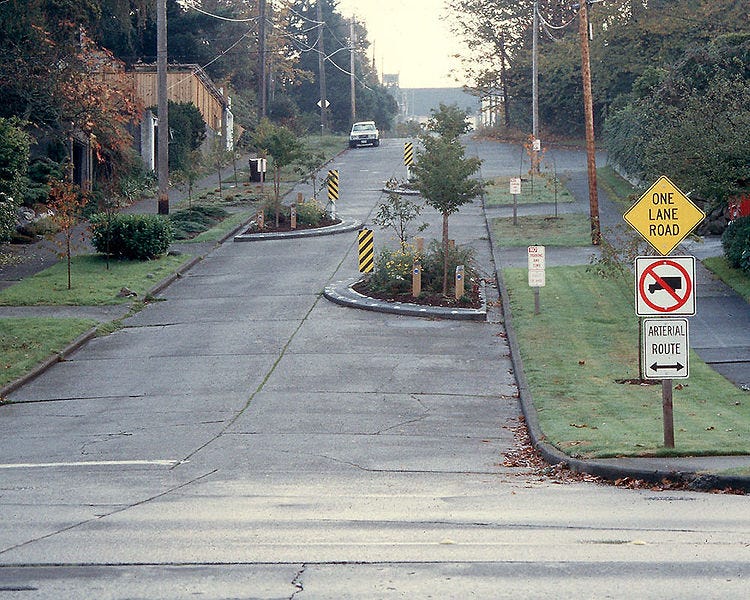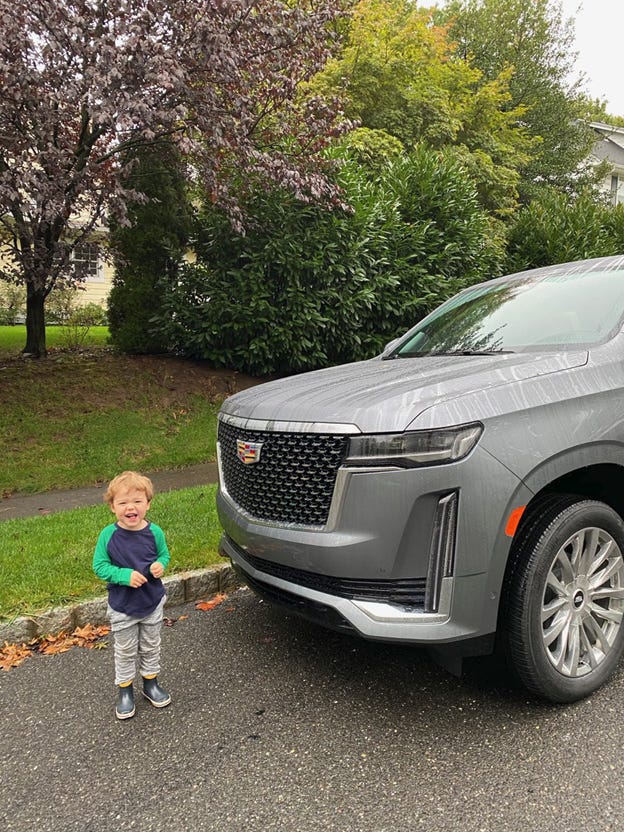Putting a Stop to Killer Cars
One American dies every 90 minutes due to getting hit by a car. It's time to stop cars from killing us.

On November 7, 2021, a six-year-old girl named Batoul Al-Fadawi died after a “sport utility vehicle” hit her as it flew down a narrow residential street at 50mph. Batoul had been playing with her sisters in Dearborn, Michigan, when the large sport utility vehicle (SUV) struck her. She died shortly thereafter, in her father’s arms, at Children’s Hospital of Michigan. Her father, Haidar Al-Fadawi, told a local journalist, “The doctors just came up to me and they told me, ‘Your daughter is dying. Just say goodbye to her.’ Within the next couple of minutes ... she died in my arms.”
What happened to six-year-old Batoul is any parent’s worst nightmare. I want to express my deepest condolences to Batoul’s family and to everyone in her community affected by her death.
Thinking about a tragedy like this, it’s easy to focus on the person responsible, the driver of the SUV. Some (who do not shy away from victim-blaming) might think about what Batoul or her caretakers should have done differently. Many will do neither, and simply say this is a “tragedy,” where nothing could have been done differently. Yes, losing a child like this is tragic, but things could have been done differently over the past 100 years that would have kept Batoul safer as she played near the transportation system near her front yard.
Looking carefully at the transportation system is the only way to prevent tragedies like the collision that killed Batoul.

Cars Kill People
Batoul had to shoulder almost all of the risk associated with the cars traveling on the street where she was playing with her sisters. Drivers and passengers in the cars have all the physical protections built into their vehicles: seat belts, steel cages around their cabin, advanced braking and collision-avoidance systems, airbags. People walking (and children playing) near most residential streets in America have only the physical protection provided by painted lines and posted signs.
Given these conditions, it should be no surprise to learn that, every single day, hundreds of people die while walking near or on roads in the United States. Cars kill, on average, a “pedestrian” once every hour-and-a-half. In 2020, cars and trucks killed 6,236 pedestrians in the United States (and they killed almost exactly the same number in 2019: 6,205).
It should also come as no surprise that your risk of death due to a car colliding with your body increase if you have lower income, if you’re a Black person, and if you live in an urban area.
With numbers like these, it’s not just the fault of the people driving the cars. This is a systemic issue. Sure, distracted driving is worse now than perhaps ever before, what with flashy touchscreens on dashboards and smartphones in our hands. But even if every driver in America had the best education on safety, and focused 100% on driving, we’d still have thousands dead in car collisions every year.
These kinds of risks are, to use perhaps the word of the year 2022, endemic. We’ve gotten used to them. We walk around as though the roads are dangerous—because they are.
It’s Getting Worse, Not Better
Even though we face an epidemic of deaths from cars, we shouldn’t feel like everything is OK, or that it will gradually get better. Quite the opposite.
Over the past few years, there have been an increasing number of deaths caused by cars. Compared to the early 2010s, things are even worse. Even though cars have more safety features, cars are killing more people now than they did a decade ago.
Car safety features help keep drivers and passengers safe. That’s great, but the industry and regulators both have paid too little attention to safety for pedestrians (and bicyclists). “Advancing technology” doesn’t magically make cars safer for everyone. Here’s an easy example: it took over a decade for U.S. safety regulations to require sound effects for electric or hybrid cars that have no engine noises. Congress passed a law requiring these safety sounds in 2010, but they are only required in “fifty percent of quiet vehicles” sold by 2020. Why did it take so long to establish even that minimal safety standard? Because car industry marketers and engineers did not think it was important enough to signal the existence of a moving car to pedestrians, who have grown accustomed to using their sense of hearing to help avoid collisions with these deadly machines. Also, industry lobbyists and electric car enthusiasts fought against the “added noise” safety requirement for style reasons.
Meanwhile, as safety regulations are delayed and denied, marketing departments have reveled in a profitable new trend of ridiculously large, overpriced, and deadly cars and SUVs. Look at, for example, this SUV currently for sale from General Motors.
Andrew J. Hawkins wrote a scathing review of this obscene vehicle for The Verge. He found it “stressful” to drive, due to feeling like he could easily harm someone while moving this behemoth around town. “An entire kindergarten class could be lined up in front of this vehicle and I wouldn’t see them,” he observed. He took a photo of his three-year-old son, standing right next to the oversized front end of the vehicle, vividly illustrating the horrors that this car produce for the people around it. One industry observer estimates that GM has sold at least 40,000 of these monstrosities in the United States alone.
I have a five-year-old daughter. We walk and bike around our (relatively low-traffic) neighborhood all the time. I’m terrified that a car will strike her. In fact, at the end of my block is an intersection with a major road. We used to cross it, twice a day, to get to preschool. The only barrier separating my kid from cars traveling at about 40 or 50mph is a tiny 5-inch curb. At the pedestrian crossing, there is a busy parking lot used by a restaurant. When we stand at that crossing, we are unavoidably sandwiched in between cars—many of them huge SUVs. That (very ordinary) intersection literally keeps me up at night. It’s terrifying.
Even the most careful driver will struggle to avoid colliding with people while driving in the United States. Our streets and our vehicles are not built to prioritize safety. They are built to prioritize speed, and to give drivers as much “freedom” as possible. This is what needs to change.
Fix Or Repair Daily: Let’s build some safety upgrades
There is no need for us to live in abject fear of cars. Engineers have developed a wide range of options to improve safety for city streets. All we need to do is build safety infrastructure, and we can save thousands of lives every year. Yes—as long as we have metal cans moving around our cities, people will get hurt—but we can still do a lot to make these killing machines safer.

For example, we can build much more traffic calming into our streets. Basically these are barriers to keep cars away from people, and to force cars to travel more slowly. My favorite idea is to build rougher road surfaces that force cars to slow down in residential neighborhoods, like the one where Batoul was killed. Most of these kinds of upgrades would require relatively little funding, and most of the planning has already been done thanks to decades of research. All we lack is political will.
After infrastructure upgrades, additional safety measures should be required in all cars. Right now, high-tech “auto braking” or collision avoidance technology is a feature that the car industry reserves for high-priced luxury cars or as expensive optional equipment. These safety features should be required for every car sold in the U.S. In addition, we should study the possibility of adding GPS enabled speed governors, to reduce the speed of cars in school zones, residential areas, and in other places where pedestrians might not have sufficient safety from the surrounding infrastructure. Yes—we can force cars to travel more slowly by making their engines incapable of high speed in those sensitive areas. When someone is hit by a car moving more slowly, they have a greater chance of escaping with their lives. It’s that simple.
Most importantly, we need to reduce the number of cars. We need to provide safer, accessible, effective, and affordable transportation options to every American. More busses, trains, and bikes mean fewer cars, SUVs, and trucks. When the U.S. has better transportation, fewer people will be killed by cars. And then, after these transportation options are in place (in the coming years,) we can stop subsidizing car ownership. We could charge higher registration fees, and raise tolls on our roadways, to make drivers pay something more like the actual cost of maintaining the infrastructure of driving. We could better regulate the finance and insurance industries to make car ownership better reflect their true social costs. When people have better transportation options, besides driving a car, then these kinds of changes become possible.
I often think back to the two years that I lived in Japan. I did not live in a major city. I lived in Shiga Prefecture, in a place my Japanese friends called “out in the country.” I did not own a car. My employer provided me with a bicycle. The bike enabled me to go to work, grocery shopping, out to meet people. It was a five minute ride to my local Japan Rail train station. Frequent, affordable trains from this “countryside” station could take me anywhere I needed to go. Transportation was safe, easy, and fun.
In the U.S., very few people can live that lifestyle. Instead, most Americans have little choice besides cars to get where they need to go. In places with a lot of traffic jams (i.e., just about every U.S. city), transportation is unsafe, difficult, and soul crushing.
It’s time for Americans to demand better. We currently have a Secretary of Transportation in Washington who claims to be interested in making our streets safer. Make sure he hears from you. Get involved locally to demand more pedestrian safety from your city council. Some of what we need won’t happen without many acts of Congress—but a lot of safety upgrades are possible with minimal local investments. Let’s get to work.
Further Reading
Harry Grabar on enforcing speed limits with, for example, speed cameras.
Shane Snowdon on what it feels like when you kill someone with your car.
Familes for Safe Streets on how to confront traffic violence in your town.



